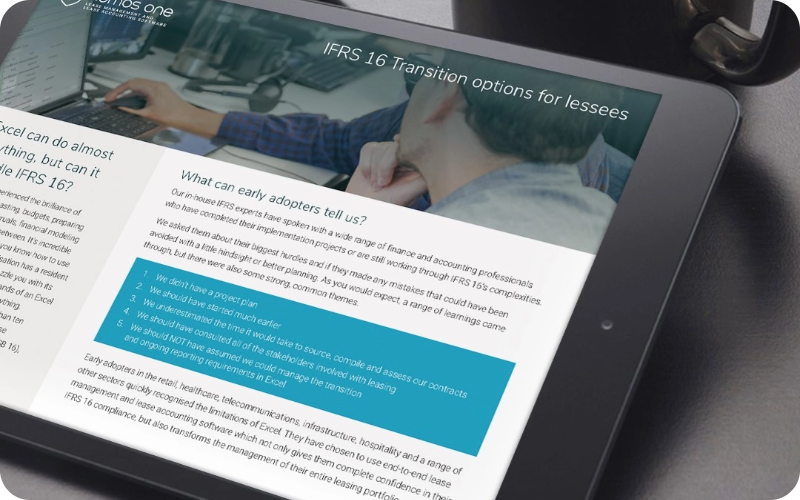Leasing plays a significant role in today's business landscape, enabling organisations to access vital assets without the burden of ownership. However, the introduction of IFRS 16 (AASB 16) has brought significant changes to how companies recognise and report leases on their financial statements. While offering increased transparency and comparability, the standard has also made lease accounting more complex and introduced new challenges and potential risks for accountants and finance professionals.
Lease risks can have significant financial and operational implications for organisations. This article discusses the common risks associated with lease agreements and explores various practical strategies to mitigate lease risk, streamline lease management, and promote compliance with the current accounting standards.

Common lease risks:
Identification of leases
Correctly identifying whether a contract is or contains a lease is critical. Incorrectly assessing a lease can inflate liabilities, impact financial ratios and lead to misstatement of liabilities and expenses, ultimately impacting financial performance and decision-making.
To mitigate the risk of inaccurately defining leases, a company can implement robust lease identification procedures, establishing clear criteria for lease identification based on IFRS 16 definitions and guidance. The next step could be to utilise technology to automate data collection and analysis to identify potential leases across all contracts. It is also advisable to seek professional guidance when needed.
Lease term determination
Inaccurately estimating lease terms can lead to misstatement of lease liabilities, right-of-use assets, interest expense and depreciation.
To prevent this, lease agreements should be carefully analysed at lease commencement, as well as on an ongoing basis. In addition, businesses should consider renewal options and aim to involve key stakeholders in lease term assessments. This will be beneficial not only for lease accounting but also for operational purposes.
Discount rate selection and application
Choosing an inappropriate discount rate can significantly impact the present value of lease payments and balance sheet liabilities. The interest rate applied to a lease is required in order to reflect that it is a financing arrangement for the use of an asset.
It is highly beneficial for organisations across all sectors to regularly conduct thorough market research, establish a clear discount rate policy based on market data and relevant benchmarks and document the rationale for each selection.
Residual value estimation
Overestimating residual values can also pose a risk of understating lease liabilities and future depreciation charges. The residual value is an asset's value at the end of the lease. This can have flow on effects to purchase options or lease extensions.
However, this can be helped by employing independent valuations when necessary, paying attention to market trends, assessing industry-specific factors, and regularly reviewing residual value estimates.
.png?width=2000&height=1500&name=Nomos%20FB%20%20IN%20Templates%20(2).png)
Data management
Accurate lease data management is crucial for mitigating risks and achieving compliance, as inadequate data management leads to errors, omissions, and compliance issues.
Best practices for organising and maintaining lease data include implementing a centralised lease repository, automating data capture and calculations, and tracking key lease terms, which leads to better visibility and control over lease portfolios. Consider using a dedicated lease tracking software solution to centralise lease data, streamline record-keeping, and promote data accuracy and completeness. It is also important to conduct periodic reviews to identify changes in lease terms, modifications, and potential lease terminations and update lease data and accounting records accordingly.
Compliance monitoring and reporting
Lease reporting requires information to be up to date, as delays in accounting for leases can impact financial reporting timelines and accuracy. This is why managing how leases are kept up to date for reporting requirements is vital.
Businesses should make sure their finance professionals are well-versed in the intricacies of compliance monitoring under IFRS 16. It could also be beneficial to learn how lease accounting and lease management software can streamline compliance reporting, helping with accurate calculations of lease liabilities and providing transparent audit trails.
Internal controls
Weak internal controls can compromise data integrity and increase the risk of fraud and errors.
Companies can establish robust internal controls and clear policies and procedures for lease accounting processes, data management, and lease modification tracking to prevent this. Specific roles can be assigned to team members responsible for lease-related tasks. It would also be helpful to implement regular reviews and audits to be able to comply with accounting standards.
Manual processes and technology
Manual lease accounting processes can be inefficient, error-prone, and time-consuming. Lack of proper technology often hinders data accuracy, timely reporting, and effective risk management.
That is why it is best to embrace the power of technology in mitigating lease risks and invest in dedicated lease administration software to automate lease calculations, journal entries, contract tracking, disclosure preparation, and compliance alerts. The benefits of utilising lease tracking software lie in improved data accuracy, streamlined reporting processes, automation of critical processes and tasks, reduction of errors, and better visibility.
Leveraging data insights
Finally, businesses should harness the potential of lease data beyond compliance. Finance professionals can extract valuable insights from their lease portfolios to drive strategic decision-making. From identifying cost-saving opportunities to optimising space utilisation, data can be leveraged to drive advantages for the business.

Mitigating lease risk is a critical task for finance professionals navigating the complexities of IFRS 16 (AASB 16) which requires a proactive and multifaceted approach. This may include understanding the accounting standards, identifying lease risks, implementing effective lease data management, and utilising lease accounting software.
By implementing these strategies, finance professionals can streamline lease management, improve financial transparency, simplify compliance, and make informed business decisions. In addition, continuous learning, collaboration with key stakeholders, and seeking professional guidance when needed can further safeguard your company's financial health.
Disclaimer: This guide is for informational purposes only and does not constitute professional accounting or legal advice. Consult qualified professionals for guidance specific to your company's needs and circumstances.

























